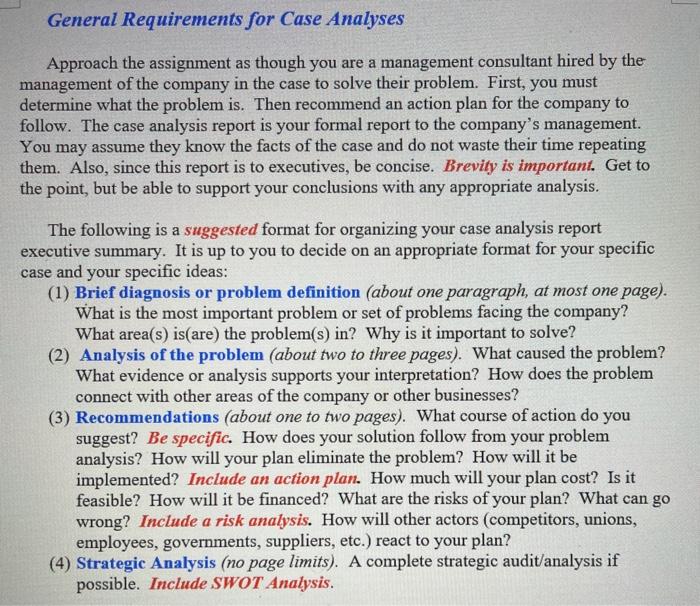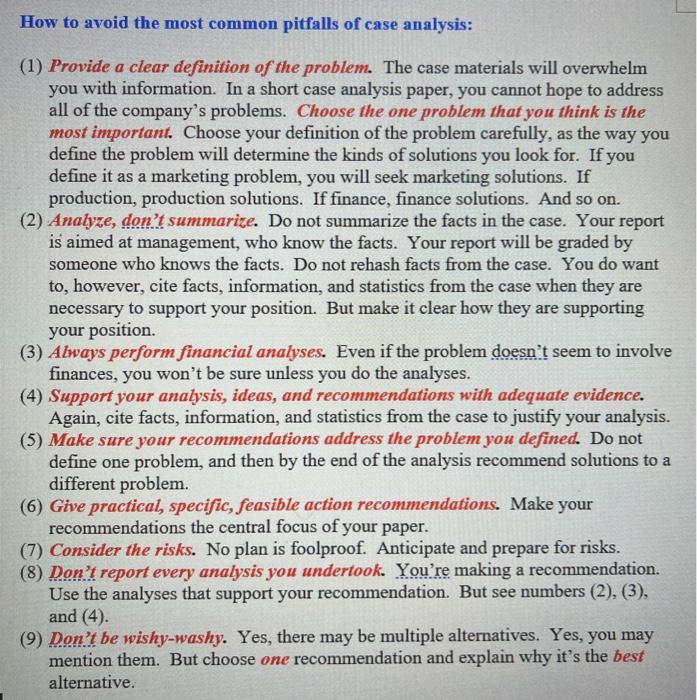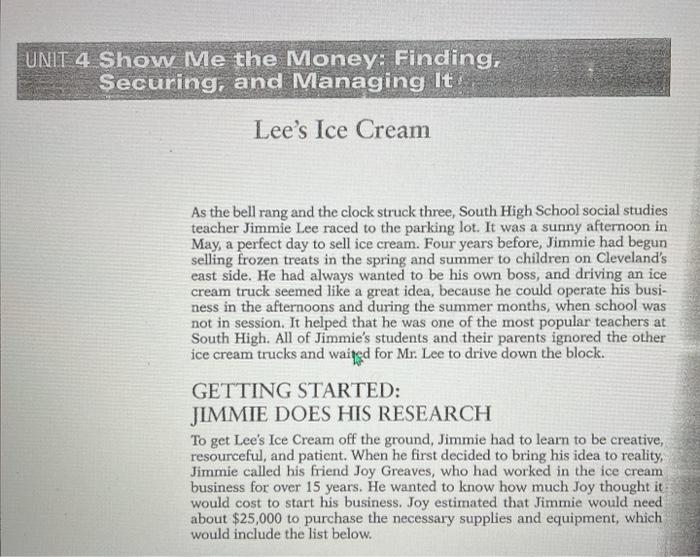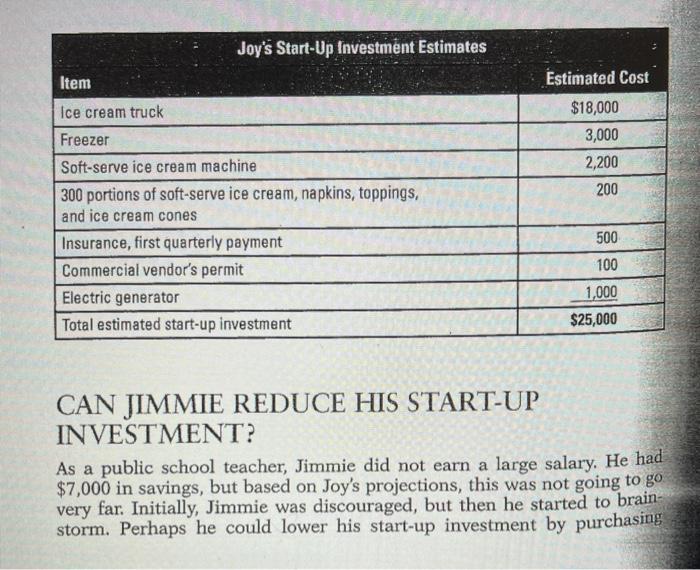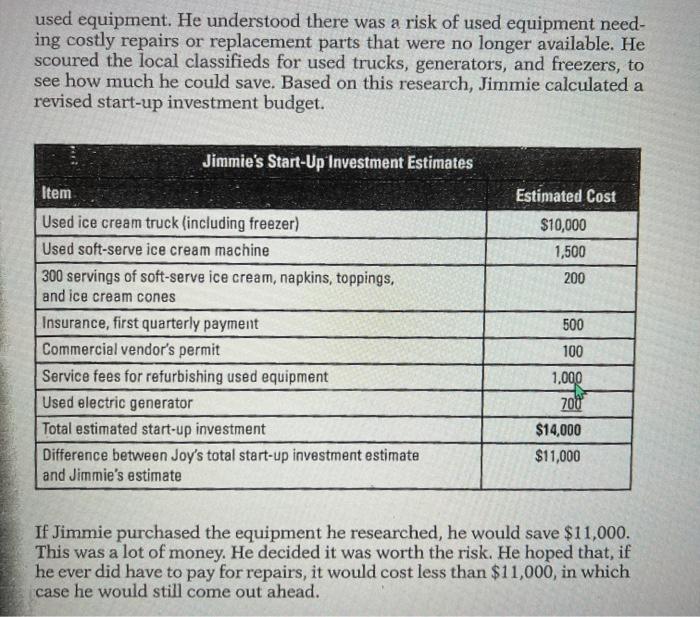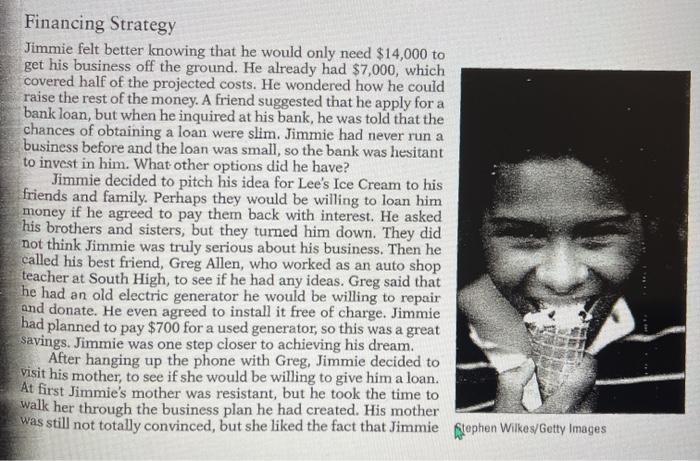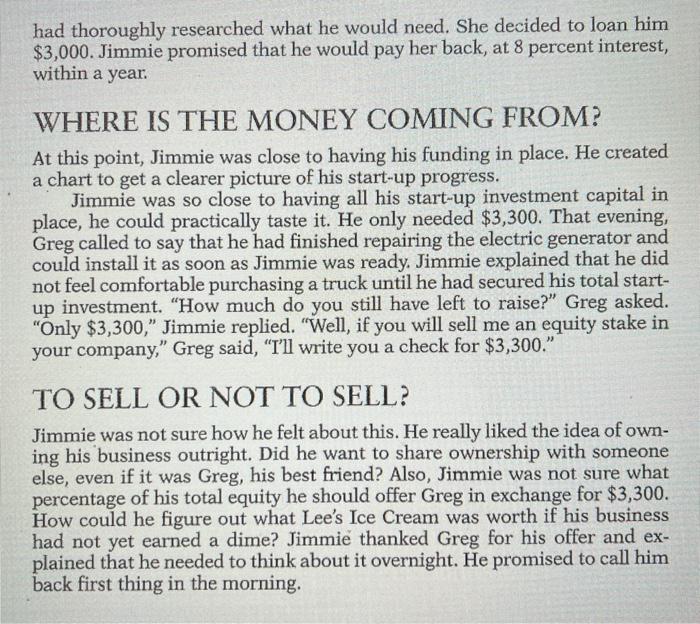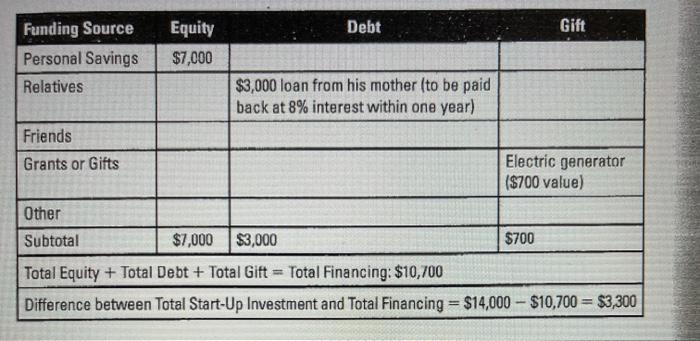Case Analysis
In this assignment, analyze and prepare for the case, "Lee's Ice Cream". The analysis report should identify issues, analyze causes or consequences related to those issues, and conclude with recommendations that address those issues.
please need help. Will rate
Thank you in advance
General Requirements for Case Analyses Approach the assignment as though you are a management consultant hired by the management of the company in the case to solve their problem. First, you must determine what the problem is. Then recommend an action plan for the company to follow. The case analysis report is your formal report to the company's management. You may assume they know the facts of the case and do not waste their time repeating them. Also, since this report is to executives, be concise. Brevity is important. Get to the point, but be able to support your conclusions with any appropriate analysis. The following is a suggested format for organizing your case analysis report executive summary. It is up to you to decide on an appropriate format for your specific case and your specific ideas: (1) Brief diagnosis or problem definition (about one paragraph, at most one page). What is the most important problem or set of problems facing the company? What area(s) isare) the problem(s) in? Why is it important to solve? (2) Analysis of the problem (about two to three pages). What caused the problem? What evidence or analysis supports your interpretation? How does the problem connect with other areas of the company or other businesses? (3) Recommendations (about one to two pages). What course of action do you suggest? Be specific. How does your solution follow from your problem analysis? How will your plan eliminate the problem? How will it be implemented? Include an action plan. How much will your plan cost? Is it feasible? How will it be financed? What are the risks of your plan? What can go wrong? Include a risk analysis. How will other actors (competitors, unions, employees, governments, suppliers, etc.) react to your plan? (4) Strategic Analysis (no page limits). A complete strategic audit/analysis if possible. Include SWOT Analysis. How to avoid the most common pitfalls of case analysis: (1) Provide a clear definition of the problem. The case materials will overwhelm you with information. In a short case analysis paper, you cannot hope to address all of the company's problems. Choose the one problem that you think is the most important. Choose your definition of the problem carefully, as the way you define the problem will determine the kinds of solutions you look for. If you define it as a marketing problem, you will seek marketing solutions. If production, production solutions. If finance, finance solutions. And so on. (2) Analyze, don't summarize. Do not summarize the facts in the case. Your report is aimed at management, who know the facts. Your report will be graded by someone who knows the facts. Do not rehash facts from the case. You do want to, however, cite facts, information, and statistics from the case when they are necessary to support your position. But make it clear how they are supporting your position. (3) Always perform financial analyses. Even if the problem doesn't seem to involve finances, you won't be sure unless you do the analyses. (4) Support your analysis, ideas, and recommendations with adequate evidence. Again, cite facts, information, and statistics from the case to justify your analysis. (5) Make sure your recommendations address the problem you defined. Do not define one problem, and then by the end of the analysis recommend solutions to a different problem. (6) Give practical, specific, feasible action recommendations. Make your recommendations the central focus of your paper. (7) Consider the risks. No plan is foolproof. Anticipate and prepare for risks. (8) Don't report every analysis you undertook. You're making a recommendation. Use the analyses that support your recommendation. But see numbers (2), (3), and (4) (9) Don't be wishy-washy. Yes, there may be multiple alternatives. Yes, you may mention them. But choose one recommendation and explain why it's the best alternative. UNIT 4 Show Me the Money: Finding, Securing, and Managing It Lee's Ice Cream As the bell rang and the clock struck three, South High School social studies teacher Jimmie Lee raced to the parking lot. It was a sunny afternoon in May, a perfect day to sell ice cream. Four years before, Jimmie had begun selling frozen treats in the spring and summer to children on Cleveland's east side. He had always wanted to be his own boss, and driving an ice cream truck seemed like a great idea, because he could operate his busi- ness in the afternoons and during the summer months, when school was not in session. It helped that he was one of the most popular teachers at South High. All of Jimmie's students and their parents ignored the other ice cream trucks and waited for Mr. Lee to drive down the block. GETTING STARTED: JIMMIE DOES HIS RESEARCH To get Lee's Ice Cream off the ground, Jimmie had to learn to be creative, resourceful, and patient. When he first decided to bring his idea to reality, Jimmie called his friend Joy Greaves, who had worked in the ice cream business for over 15 years. He wanted to know how much Joy thought it would cost to start his business. Joy estimated that Jimmie would need about $25,000 to purchase the necessary supplies and equipment, which would include the list below. Joy's Start-Up Investment Estimates Item Estimated Cost $18,000 3,000 2,200 200 Ice cream truck Freezer Soft-serve ice cream machine 300 portions of soft-serve ice cream, napkins, toppings, and ice cream cones Insurance, first quarterly payment Commercial vendor's permit Electric generator Total estimated start-up investment 500 100 1,000 $25,000 CAN JIMMIE REDUCE HIS START-UP INVESTMENT? As a public school teacher, Jimmie did not earn a large salary. He had $7,000 in savings, but based on Joy's projections, this was not going to go very far. Initially, Jimmie was discouraged, but then he started to brain- storm. Perhaps he could lower his start-up investment by purchasing used equipment. He understood there was a risk of used equipment need- ing costly repairs or replacement parts that were no longer available. He scoured the local classifieds for used trucks, generators, and freezers, to see how much he could save. Based on this research, Jimmie calculated a revised start-up investment budget. Jimmie's Start-Up Investment Estimates Estimated Cost $10,000 1,500 200 500 Item Used ice cream truck (including freezer) Used soft-serve ice cream machine 300 servings of soft-serve ice cream, napkins, toppings, and ice cream cones Insurance, first quarterly payment Commercial vendor's permit Service fees for refurbishing used equipment Used electric generator Total estimated start-up investment Difference between Joy's total start-up investment estimate and Jimmie's estimate 100 1,000 2010 $14,000 $11,000 If Jimmie purchased the equipment he researched, he would save $11,000. This was a lot of money. He decided it was worth the risk. He hoped that, if he ever did have to pay for repairs, it would cost less than $11,000, in which case he would still come out ahead. Financing Strategy Jimmie felt better knowing that he would only need $14,000 to get his business off the ground. He already had $7,000, which covered half of the projected costs. He wondered how he could raise the rest of the money. A friend suggested that he apply for a bank loan, but when he inquired at his bank, he was told that the chances of obtaining a loan were slim. Jimmie had never run a business before and the loan was small, so the bank was hesitant to invest in him. What other options did he have? Jimmie decided to pitch his idea for Lee's Ice Cream to his friends and family. Perhaps they would be willing to loan him money if he agreed to pay them back with interest. He asked his brothers and sisters, but they turned him down. They did not think Jimmie was truly serious about his business. Then he called his best friend, Greg Allen, who worked as an auto shop teacher at South High, to see if he had any ideas. Greg said that he had an old electric generator he would be willing to repair and donate. He even agreed to install it free of charge. Jimmie had planned to pay $700 for a used generator, so this was a great Savings. Jimmie was one step closer to achieving his dream. After hanging up the phone with Greg, Jimmie decided to visit his mother, to see if she would be willing to give him a loan. At first Jimmie's mother was resistant, but he took the time to walk her through the business plan he had created. His mother was still not totally convinced, but she liked the fact that Jimmie Batephen Wilkes/Getty Images had thoroughly researched what he would need. She decided to loan him $3,000. Jimmie promised that he would pay her back, at 8 percent interest, within a year. WHERE IS THE MONEY COMING FROM? At this point, Jimmie was close to having his funding in place. He created a chart to get a clearer picture of his start-up progress. Jimmie was so close to having all his start-up investment capital in place, he could practically taste it. He only needed $3,300. That evening, Greg called to say that he had finished repairing the electric generator and could install it as soon as Jimmie was ready. Jimmie explained that he did not feel comfortable purchasing a truck until he had secured his total start- up investment. "How much do you still have left to raise?" Greg asked. "Only $3,300," Jimmie replied. "Well, if you will sell me an equity stake in your company," Greg said, "I'll write you a check for $3,300." TO SELL OR NOT TO SELL? Jimmie was not sure how he felt about this. He really liked the idea of own- ing his business outright. Did he want to share ownership with someone else, even if it was Greg, his best friend? Also, Jimmie was not sure what percentage of his total equity he should offer Greg in exchange for $3,300. How could he figure out what Lee's Ice Cream was worth if his business had not yet earned a dime? Jimmie thanked Greg for his offer and ex- plained that he needed to think about it overnight. He promised to call him back first thing in the morning. Funding Source Equity Debt Gift Personal Savings $7,000 Relatives $3,000 loan from his mother (to be paid back at 8% interest within one year) Friends Grants or Gifts Electric generator ($700 value) Other Subtotal $7,000 $3,000 $700 Total Equity + Total Debt + Total Gift = Total Financing: $10,700 Difference between Total Start-Up Investment and Total Financing = $14,000 - $10,700 = $3,300 General Requirements for Case Analyses Approach the assignment as though you are a management consultant hired by the management of the company in the case to solve their problem. First, you must determine what the problem is. Then recommend an action plan for the company to follow. The case analysis report is your formal report to the company's management. You may assume they know the facts of the case and do not waste their time repeating them. Also, since this report is to executives, be concise. Brevity is important. Get to the point, but be able to support your conclusions with any appropriate analysis. The following is a suggested format for organizing your case analysis report executive summary. It is up to you to decide on an appropriate format for your specific case and your specific ideas: (1) Brief diagnosis or problem definition (about one paragraph, at most one page). What is the most important problem or set of problems facing the company? What area(s) isare) the problem(s) in? Why is it important to solve? (2) Analysis of the problem (about two to three pages). What caused the problem? What evidence or analysis supports your interpretation? How does the problem connect with other areas of the company or other businesses? (3) Recommendations (about one to two pages). What course of action do you suggest? Be specific. How does your solution follow from your problem analysis? How will your plan eliminate the problem? How will it be implemented? Include an action plan. How much will your plan cost? Is it feasible? How will it be financed? What are the risks of your plan? What can go wrong? Include a risk analysis. How will other actors (competitors, unions, employees, governments, suppliers, etc.) react to your plan? (4) Strategic Analysis (no page limits). A complete strategic audit/analysis if possible. Include SWOT Analysis. How to avoid the most common pitfalls of case analysis: (1) Provide a clear definition of the problem. The case materials will overwhelm you with information. In a short case analysis paper, you cannot hope to address all of the company's problems. Choose the one problem that you think is the most important. Choose your definition of the problem carefully, as the way you define the problem will determine the kinds of solutions you look for. If you define it as a marketing problem, you will seek marketing solutions. If production, production solutions. If finance, finance solutions. And so on. (2) Analyze, don't summarize. Do not summarize the facts in the case. Your report is aimed at management, who know the facts. Your report will be graded by someone who knows the facts. Do not rehash facts from the case. You do want to, however, cite facts, information, and statistics from the case when they are necessary to support your position. But make it clear how they are supporting your position. (3) Always perform financial analyses. Even if the problem doesn't seem to involve finances, you won't be sure unless you do the analyses. (4) Support your analysis, ideas, and recommendations with adequate evidence. Again, cite facts, information, and statistics from the case to justify your analysis. (5) Make sure your recommendations address the problem you defined. Do not define one problem, and then by the end of the analysis recommend solutions to a different problem. (6) Give practical, specific, feasible action recommendations. Make your recommendations the central focus of your paper. (7) Consider the risks. No plan is foolproof. Anticipate and prepare for risks. (8) Don't report every analysis you undertook. You're making a recommendation. Use the analyses that support your recommendation. But see numbers (2), (3), and (4) (9) Don't be wishy-washy. Yes, there may be multiple alternatives. Yes, you may mention them. But choose one recommendation and explain why it's the best alternative. UNIT 4 Show Me the Money: Finding, Securing, and Managing It Lee's Ice Cream As the bell rang and the clock struck three, South High School social studies teacher Jimmie Lee raced to the parking lot. It was a sunny afternoon in May, a perfect day to sell ice cream. Four years before, Jimmie had begun selling frozen treats in the spring and summer to children on Cleveland's east side. He had always wanted to be his own boss, and driving an ice cream truck seemed like a great idea, because he could operate his busi- ness in the afternoons and during the summer months, when school was not in session. It helped that he was one of the most popular teachers at South High. All of Jimmie's students and their parents ignored the other ice cream trucks and waited for Mr. Lee to drive down the block. GETTING STARTED: JIMMIE DOES HIS RESEARCH To get Lee's Ice Cream off the ground, Jimmie had to learn to be creative, resourceful, and patient. When he first decided to bring his idea to reality, Jimmie called his friend Joy Greaves, who had worked in the ice cream business for over 15 years. He wanted to know how much Joy thought it would cost to start his business. Joy estimated that Jimmie would need about $25,000 to purchase the necessary supplies and equipment, which would include the list below. Joy's Start-Up Investment Estimates Item Estimated Cost $18,000 3,000 2,200 200 Ice cream truck Freezer Soft-serve ice cream machine 300 portions of soft-serve ice cream, napkins, toppings, and ice cream cones Insurance, first quarterly payment Commercial vendor's permit Electric generator Total estimated start-up investment 500 100 1,000 $25,000 CAN JIMMIE REDUCE HIS START-UP INVESTMENT? As a public school teacher, Jimmie did not earn a large salary. He had $7,000 in savings, but based on Joy's projections, this was not going to go very far. Initially, Jimmie was discouraged, but then he started to brain- storm. Perhaps he could lower his start-up investment by purchasing used equipment. He understood there was a risk of used equipment need- ing costly repairs or replacement parts that were no longer available. He scoured the local classifieds for used trucks, generators, and freezers, to see how much he could save. Based on this research, Jimmie calculated a revised start-up investment budget. Jimmie's Start-Up Investment Estimates Estimated Cost $10,000 1,500 200 500 Item Used ice cream truck (including freezer) Used soft-serve ice cream machine 300 servings of soft-serve ice cream, napkins, toppings, and ice cream cones Insurance, first quarterly payment Commercial vendor's permit Service fees for refurbishing used equipment Used electric generator Total estimated start-up investment Difference between Joy's total start-up investment estimate and Jimmie's estimate 100 1,000 2010 $14,000 $11,000 If Jimmie purchased the equipment he researched, he would save $11,000. This was a lot of money. He decided it was worth the risk. He hoped that, if he ever did have to pay for repairs, it would cost less than $11,000, in which case he would still come out ahead. Financing Strategy Jimmie felt better knowing that he would only need $14,000 to get his business off the ground. He already had $7,000, which covered half of the projected costs. He wondered how he could raise the rest of the money. A friend suggested that he apply for a bank loan, but when he inquired at his bank, he was told that the chances of obtaining a loan were slim. Jimmie had never run a business before and the loan was small, so the bank was hesitant to invest in him. What other options did he have? Jimmie decided to pitch his idea for Lee's Ice Cream to his friends and family. Perhaps they would be willing to loan him money if he agreed to pay them back with interest. He asked his brothers and sisters, but they turned him down. They did not think Jimmie was truly serious about his business. Then he called his best friend, Greg Allen, who worked as an auto shop teacher at South High, to see if he had any ideas. Greg said that he had an old electric generator he would be willing to repair and donate. He even agreed to install it free of charge. Jimmie had planned to pay $700 for a used generator, so this was a great Savings. Jimmie was one step closer to achieving his dream. After hanging up the phone with Greg, Jimmie decided to visit his mother, to see if she would be willing to give him a loan. At first Jimmie's mother was resistant, but he took the time to walk her through the business plan he had created. His mother was still not totally convinced, but she liked the fact that Jimmie Batephen Wilkes/Getty Images had thoroughly researched what he would need. She decided to loan him $3,000. Jimmie promised that he would pay her back, at 8 percent interest, within a year. WHERE IS THE MONEY COMING FROM? At this point, Jimmie was close to having his funding in place. He created a chart to get a clearer picture of his start-up progress. Jimmie was so close to having all his start-up investment capital in place, he could practically taste it. He only needed $3,300. That evening, Greg called to say that he had finished repairing the electric generator and could install it as soon as Jimmie was ready. Jimmie explained that he did not feel comfortable purchasing a truck until he had secured his total start- up investment. "How much do you still have left to raise?" Greg asked. "Only $3,300," Jimmie replied. "Well, if you will sell me an equity stake in your company," Greg said, "I'll write you a check for $3,300." TO SELL OR NOT TO SELL? Jimmie was not sure how he felt about this. He really liked the idea of own- ing his business outright. Did he want to share ownership with someone else, even if it was Greg, his best friend? Also, Jimmie was not sure what percentage of his total equity he should offer Greg in exchange for $3,300. How could he figure out what Lee's Ice Cream was worth if his business had not yet earned a dime? Jimmie thanked Greg for his offer and ex- plained that he needed to think about it overnight. He promised to call him back first thing in the morning. Funding Source Equity Debt Gift Personal Savings $7,000 Relatives $3,000 loan from his mother (to be paid back at 8% interest within one year) Friends Grants or Gifts Electric generator ($700 value) Other Subtotal $7,000 $3,000 $700 Total Equity + Total Debt + Total Gift = Total Financing: $10,700 Difference between Total Start-Up Investment and Total Financing = $14,000 - $10,700 = $3,300
